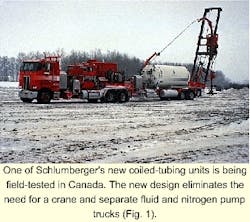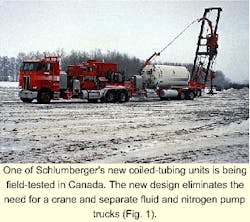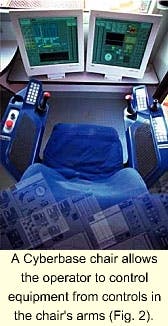Schlumberger Oilfield Services' well-intervention business unit expects a new coiled-tubing unit design, called CT Express, to reduce rig-up time, improve safety, and significantly improve efficiency and reliability of such operations as nitrogen lifts, sand cleanouts, acidizing, and fracturing.
Currently two units are in field trials-one in Canada (Fig. 1) and the other in the US.
The new design combines a truck-mounted, coiled-tubing unit with an ancillary fluid and nitrogen pump truck. These two units replace four separate units (coiled-tubing unit, crane, nitrogen pumper, and fluid pumper) typically required for many coiled-tubing jobs.
Schlumberger indicates that the new design is particularly well-suited for efficiency gains during routine operations or for leases that require equipment with a minimal footprint. It adds that the design will be capable of handling 80% of all coiled-tubing work in the intermediate depth market.
According to Schlumberger, the innovative unit layout and effective use of technology allow the units to rig-up in less than 30 min with fewer people. Rig-up of conventional coiled-tubing equipment can require 3-4 hr.
Unlike conventional coiled-tubing units that require a crane to lift the injector head onto the wellhead, the new design incorporates a 32-ft mast for carrying and positioning the injector onto the wellhead. This improves safety by eliminating the need for people to work on and underneath a suspended load.
A single operator controls both the coiled-tubing and pumping operation from the control cabin that revolves around a Cyberbase control chair (Fig. 2). This type of "fly by wire" control eliminates the control panel and allows the operator to control both units from controls in the arms of the chair.
In a conventional coiled-tubing operation, one operator is required for each of the four units on the job.
Schlumberger expects this control of all coiled-tubing and pumping functions by one operator to improve safety, job efficiency, and unit and engine management.
The nitrogen and fluid pumper consists of a cryogenic nitrogen storage tank, a nitrogen pump, and a positive displacement fluid pump, which is used to pump acid, diesel, etc.




